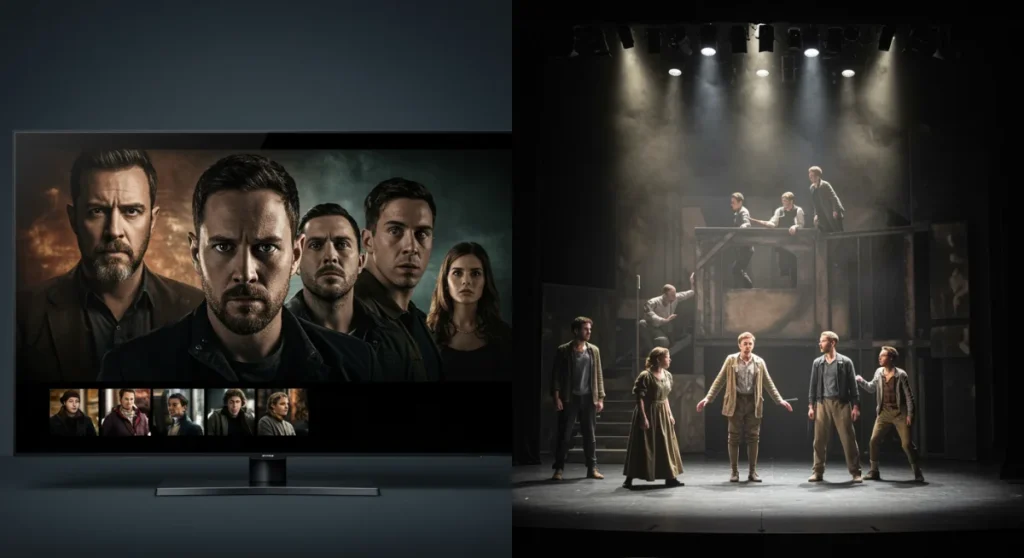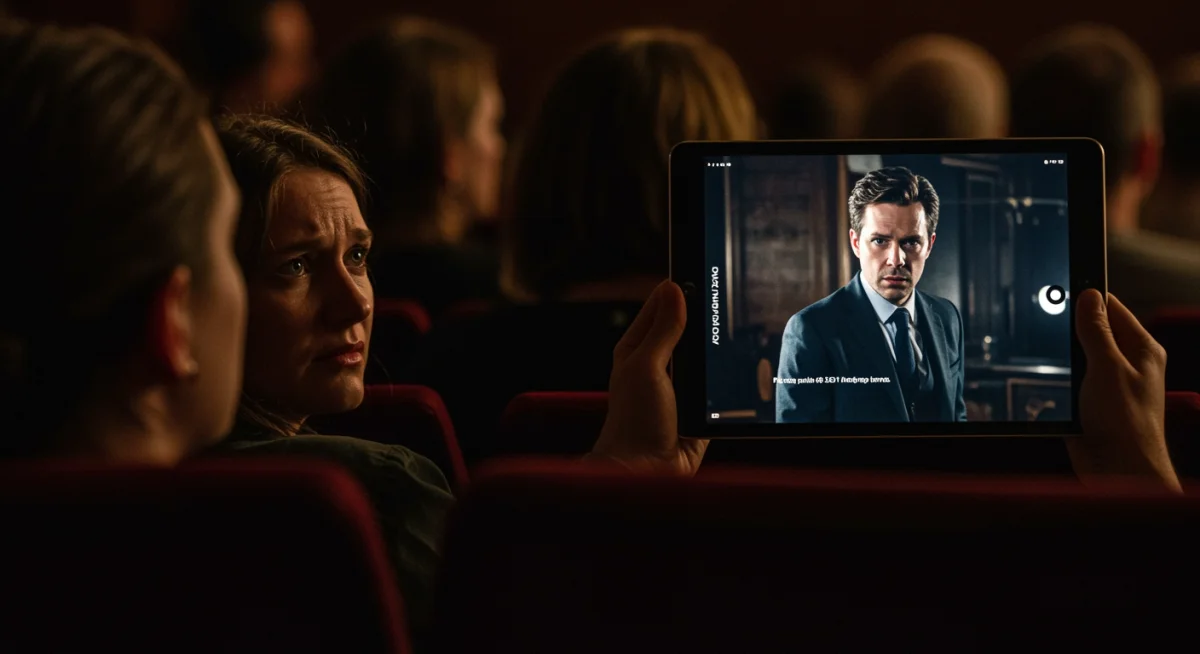Dramatic Storytelling Evolution: TV vs. Stage Over the Last Decade

The evolution of dramatic storytelling in US television and stage over the last decade reveals a dynamic interplay of narrative innovation, technological advancements, and shifting audience expectations, each medium adapting uniquely.
The landscape of narrative arts has undergone profound transformations, particularly when examining the dramatic storytelling evolution in US television versus the stage over the last decade. This period has seen both mediums push boundaries, redefine conventions, and captivate audiences in increasingly sophisticated ways. How have these distinct art forms adapted to a rapidly changing world, and what can their divergent paths tell us about the future of drama?
The Rise of Long-Form Television Narratives
Over the past ten years, US television drama has experienced a golden age, largely characterized by the proliferation of long-form, serialized storytelling. This shift from episodic, self-contained narratives to intricate, season-long arcs has fundamentally reshaped how stories are conceived and consumed. Streaming platforms have been a primary catalyst, allowing creators unprecedented freedom in terms of content, structure, and character development.
This era has seen an embrace of complexity that was once the exclusive domain of literature or high-budget cinema. Characters are no longer archetypes but deeply flawed, multi-dimensional individuals whose journeys unfold over dozens of hours. Plotlines weave together multiple perspectives, challenging viewers with moral ambiguities and intricate mysteries that demand sustained attention.
Streaming’s Impact on Narrative Depth
The advent of streaming services like Netflix, HBO Max, and Hulu has revolutionized the pacing and scale of television drama. Without the constraints of weekly broadcast schedules or strict commercial breaks, showrunners can craft narratives that breathe, allowing for slower burns, nuanced character beats, and the exploration of themes that require significant development.
- Uninterrupted Viewing: Binge-watching culture fosters a deeper immersion into complex narratives, allowing audiences to absorb intricate plot details and character motivations without interruption.
- Creative Freedom: Fewer network restrictions often translate to bolder storytelling, tackling controversial subjects and experimenting with non-linear structures.
- Global Reach: Streaming platforms enable US dramas to reach international audiences instantly, influencing global storytelling trends and fostering a more diverse cultural exchange.
In essence, television drama has evolved into a novelist’s medium, where the commitment to a story can span years, fostering a unique relationship between the audience and the evolving narrative. This extended engagement has allowed for a depth of character and plot that was previously unimaginable.
Stage Drama’s Enduring Intimacy and Innovation
While television has expanded its narrative canvas, live theater has continued to thrive by emphasizing its inherent strengths: immediacy, intimacy, and the unique connection between performers and audience. Over the last decade, stage productions in the US have often leaned into experimental forms, immersive experiences, and a renewed focus on spoken word and physical storytelling.
The stage offers a singular, unrepeatable event. Every performance is a live creation, imbued with a raw energy that television, despite its advancements, cannot replicate. This ephemerality is a powerful draw, encouraging audiences to be present and fully engaged in the unfolding drama in real-time.
Reimagining Theatrical Spaces and Engagement
Contemporary stage drama has increasingly broken free from traditional proscenium arch conventions. Productions are exploring site-specific venues, immersive sets, and interactive elements that blur the lines between audience and performer. This pushes the boundaries of what a “play” can be, transforming viewing into an active, participatory experience.
- Audience Participation: Some modern plays directly involve the audience, making them part of the narrative or inviting them to make choices that affect the story’s progression.
- Site-Specific Performances: Utilizing non-traditional spaces, such as warehouses, historical buildings, or outdoor environments, adds a unique layer of authenticity and atmosphere to the storytelling.
- Physical Storytelling: A greater emphasis on movement, dance, and non-verbal communication allows for powerful dramatic expression that transcends dialogue alone.
The stage remains a vital space for exploring urgent social and political themes with a directness that resonates profoundly in the shared space of a theater. Its ability to create a collective, communal experience in an increasingly digitized world is one of its most enduring strengths.
Character Development: Depth on Screen vs. Presence on Stage
The approach to character development in television and stage drama has diverged significantly over the past decade, reflecting the inherent capabilities and limitations of each medium. Television, with its expansive runtime, allows for a gradual, nuanced unfolding of character, while stage drama relies on the immediate, impactful presence of the actor.
In television, characters often undergo profound transformations across multiple seasons. Their backstories are meticulously unraveled, their motivations explored through intricate subplots, and their moral compasses tested repeatedly. This extended exposure allows for a deep, almost familial, connection between the audience and the fictional individuals.

The Power of the Actor’s Live Performance
On stage, character development is often condensed into a shorter timeframe, demanding intense focus and precision from both playwright and actor. The live performance accentuates the actor’s ability to embody a character fully, conveying complex emotions and motivations through voice, body language, and immediate interaction with other performers. This creates a powerful, visceral experience that is unique to theater.
- Subtlety in Dialogue: Playwrights often craft dialogue with multiple layers of meaning, allowing actors to convey subtext and inner turmoil through vocal delivery and subtle gestures.
- Physicality and Presence: The physical presence of actors on stage creates an immediate, tangible connection with the audience, making emotions and conflicts feel incredibly real.
- Unpredictability: The live nature of theater means that every performance is slightly different, offering unique interpretations and spontaneous moments that enhance the character’s authenticity.
Ultimately, while television builds character through accretion and prolonged exposure, stage drama sculpts character through intense, concentrated moments of live performance, leveraging the actor’s immediate presence to forge a powerful connection.
Technological Advancements and Their Narrative Impact
Technology has played a pivotal role in shaping the dramatic storytelling evolution in both mediums, though in distinctly different ways. For television, advancements in digital cinematography, visual effects, and sound design have opened up new frontiers for narrative spectacle and emotional immersion.
High-definition cameras, sophisticated CGI, and immersive soundscapes allow television dramas to create worlds of incredible detail and scope, from fantastical realms to gritty urban landscapes. This technological prowess supports grander narratives and more visually arresting storytelling, elevating the production values to cinematic levels.
Innovations in Stagecraft and Digital Integration
Stage drama, while traditionally more reliant on practical effects, has also embraced technology to enhance its storytelling. Projection mapping, advanced lighting systems, and integrated digital scenery are now common, allowing for dynamic set changes, atmospheric enhancements, and even interactive elements that respond to live action.
- Projection Mapping: Digital projections can transform static sets into dynamic, evolving environments, conveying changes in time, place, or emotional state instantly.
- Automated Scenery: Computer-controlled stage machinery allows for seamless and complex set transitions, creating a fluid and often breathtaking visual experience.
- Sound Design: Advanced sound systems create immersive audio environments, enhancing mood, guiding attention, and adding layers of meaning to the narrative.
These technological integrations allow stage productions to achieve new levels of visual and auditory complexity, expanding the creative palette for directors and designers, and enriching the audience’s engagement with the live narrative.
Audience Engagement and Consumption Patterns
The last decade has seen a significant divergence in how audiences engage with and consume dramatic storytelling in television versus the stage. Television, particularly with the rise of streaming, has fostered a culture of on-demand, personalized viewing, while theater continues to offer a communal, shared experience.
The ability to watch what you want, when you want, has given television viewers unprecedented control over their consumption habits. This freedom has contributed to the popularity of complex, serialized dramas, as audiences can dedicate significant time to a single narrative without external scheduling constraints. The discussions and theories generated by these shows often extend online, creating a meta-narrative around the viewing experience.
The Unique Social Aspect of Live Theater
Live theater, by contrast, demands a collective gathering. Audiences arrive at a specific time and place, sharing the experience with hundreds of other people. This communal aspect is integral to its appeal, fostering a sense of shared emotion and collective response that is distinct from individual television viewing. The immediate feedback loop between performers and audience creates a unique dynamic that influences each show.
- Shared Emotional Experience: The collective laughter, gasps, or tears in a theater amplify individual emotions, creating a powerful, unifying experience.
- Absence of Distraction: The live setting encourages a focused, uninterrupted engagement with the story, free from the temptations of multi-tasking often associated with at-home viewing.
- Post-Show Discussion: The shared experience often leads to immediate, in-person discussions and reflections among audience members, extending the impact of the drama beyond the curtain call.
Ultimately, both mediums offer compelling forms of engagement, but they cater to different human needs: television to the desire for personalized, deep-dive narratives, and theater to the timeless need for shared, immediate human connection.
Thematic Exploration and Social Relevance
Both US television and stage drama have served as vital platforms for thematic exploration and social commentary over the last decade, reflecting and shaping public discourse. However, their approaches to these weighty topics often differ due to their inherent structures and reach.
Television, with its broad reach and capacity for sustained storytelling, can delve into complex societal issues with remarkable nuance. Major dramatic series frequently tackle themes like systemic injustice, mental health, identity politics, and environmental concerns, often sparking widespread conversations and influencing cultural perspectives. The ability to present diverse viewpoints over many hours allows for a multifaceted examination of these issues.
Stage as a Catalyst for Immediate Dialogue
Stage drama, while perhaps reaching a smaller audience, often serves as a more immediate and potent catalyst for social dialogue. Its live nature allows playwrights to respond rapidly to current events, offering sharp, incisive critiques or profound meditations that resonate deeply within the intimate setting of a theater. The directness of live performance can create a powerful emotional impact, challenging audiences to confront uncomfortable truths in real-time.
- Timeliness: Playwrights can often bring new works to the stage more quickly than television productions, allowing for more immediate commentary on contemporary issues.
- Intense Focus: The concentrated nature of a play can create an incredibly focused examination of a single theme or conflict, leading to deep audience introspection.
- Community Engagement: Local theater often fosters community dialogue and outreach programs related to the themes explored in their productions, further amplifying social relevance.
Both television and stage drama remain crucial artistic avenues for engaging with the complexities of the human condition and the challenges facing society, each leveraging its unique medium to provoke thought, empathy, and conversation.
| Key Aspect | Description of Evolution |
|---|---|
| Narrative Structure | TV shifted to complex, serialized arcs; Stage maintained concentrated, immediate narratives. |
| Audience Engagement | TV fostered on-demand, individual viewing; Stage emphasized communal, live experience. |
| Technological Integration | TV utilized advanced VFX/CGI; Stage incorporated projection mapping and automated scenery. |
| Character Depth | TV developed characters over seasons; Stage relied on actor’s immediate, intense portrayal. |
Frequently Asked Questions About Dramatic Storytelling
Streaming platforms have enabled television drama to adopt more complex, serialized narratives over the last decade. Without traditional broadcast constraints, shows can develop intricate plotlines and character arcs across multiple seasons, fostering a deeper, more immersive viewing experience for audiences who often binge-watch content.
Live stage drama offers an unparalleled sense of immediacy, intimacy, and a unique communal experience. Each performance is a one-time event, creating a direct connection between actors and audience. This allows for raw, visceral emotional impact and often explores themes with a directness that resonates profoundly in the shared theatrical space.
Technology has significantly enhanced stage drama, with innovations like projection mapping, advanced lighting systems, and integrated digital scenery. These tools create dynamic visual environments, seamless set changes, and immersive atmospheric effects, expanding the creative possibilities for directors and enriching the audience’s engagement with live performances.
Television allows for gradual character development over many hours, revealing complexities through extended narratives. Stage drama, conversely, relies on the actor’s immediate, intense presence to convey character depth within a shorter timeframe, using precise dialogue, physicality, and live interaction to create impactful, concentrated portrayals.
Television fosters on-demand, individual viewing, often leading to binge-watching and online discussions. Stage drama necessitates a communal gathering, creating a shared emotional experience where collective responses amplify individual feelings. Both offer profound engagement, but cater to different desires: personalized immersion versus shared, immediate connection.
Conclusion
The past decade has been a period of remarkable innovation and divergence in the world of dramatic storytelling across US television and the stage. While television has leveraged technological advancements and the freedom of streaming to cultivate vast, intricate narratives and deep character arcs, live theater has reaffirmed its unique power through intimacy, immediacy, and the irreplaceable magic of shared, unrepeatable performances. Both mediums, far from competing, have evolved in complementary ways, each refining its distinct strengths to captivate audiences and explore the depths of the human experience. Their ongoing evolution promises a rich and varied future for dramatic arts, continually pushing the boundaries of what stories can achieve.





